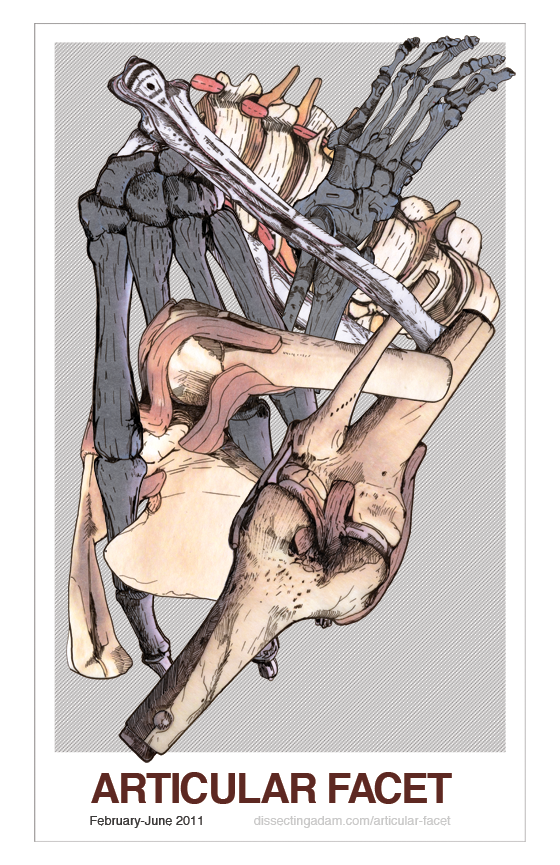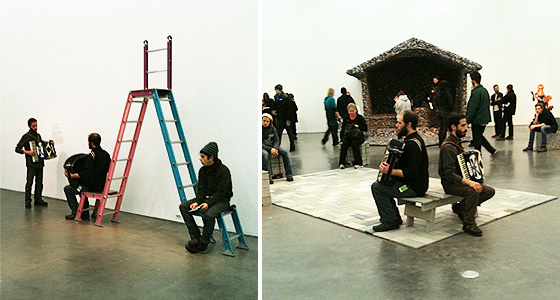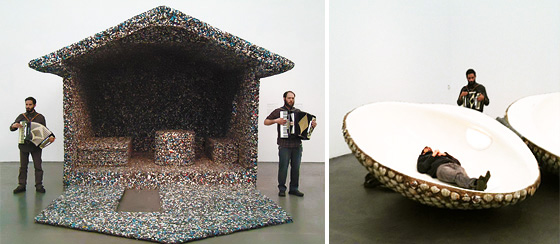
02-15-11
“February 15, 2011″ by Peter Weathers
Every new attempt at comprehensive contextualization results in that old predictable surprise—there remains the slippery more; the desire to control always Cheshire-grins at us when we reach for her. Spoken language, for instance, wants to draw coloring-book-thick lines around everything—because what can be separated can be owned and sold or bought and enslaved. This dresses up the powerful statue of control (its left tit unexposed, Ashcroft-like) in robes of concrete reality: reality can be boring.
In contrast, aesthetic experiences composed of integrity and authenticity (a painful word to write) “know” they are greater than the questions that can be asked of them but less than the universe that surrounds them. I put quotes around know because I’m indicating the human consciousness behind the created aesthetic experience. The human creator at the height of her powers creates a simile of consciousness in the successful aesthetic work: an argument about how arguments are made, winking in apparent awareness.
The beautiful thing about the language of our other senses (five, right? or has that changed, too, like Pluto?) is their inclination toward obstinate unwieldiness, no matter how hard we push the branch, the wrong way, into the wood chipper. Dancing about the Sears Tower (not gunna change it) still leaves raw sound that same slippery more; vibrations will never be full sentences of toothy words. Sound can communicate things but is never about any thing (other than itself). What it communicates always appears greater than sound but less than language—communicating more, by inference, what it seems to be unable to directly say.
and
“shoosh please!” she had said to her dad (who had been whistling lyrically) comfortably and sternly from the bathroom stall. And he had sheepishly stopped. This, in the three-year-old-girl-infiltrated men’s restroom, was desire to control environment (including people)—a natural outgrowth of our belief that we are able to control ourselves: our bodies, our thoughts. We are able to communicate with our words because we believe that they hold reality like the plastic bag holds our groceries (and yes, we feel guilty about it). How freeing and humbling it is when we are reminded that this bag can only hold so much milk before it rips.
The rip is deliciously disorienting. The best aesthetic sound experiences invoke it by inducing a cognitive synesthesia, where our movements become sights we hear and our thoughts become sounds we see—and we are reminded, like last Saturday, when the Coppice accordions duetting indistinctly with four speakers competed with LOTS of kids, that even our knowing control of an illusion is an illusion. A work which would have, in an idealized context, inspired the listener-participant to question assumptions about where sound comes from and what it indicates, instead struggled with parents planning meals, pulling on their children, and ensuring “no jumping” signs were obeyed.

The experiential map led the performers and audience-participants to a remarkable coincidence: the moment their work was “least successful” was the same geographic location as the origin of the project (during Family Day, the 6th iteration out of 7 durational performances at the Museum of Contemporary Art). By their denial, the composers discovered (perhaps) their initial unconscious and unarticulated expectations (for example, “our audience will be composed of people who can hear our work”). While consciously attempting to integrate the contingencies of “interactive” work, they reached the wall they had not known, perhaps, they had constructed in order to control what they thought (perhaps) would not be controlled (or, minimally controlled). In reaching the limits of an idealized experience, one faces the context in which the idealization was formed, and can be again surprised at one’s unconscious desire to control. An aesthetic piece that integrates its audience into itself will still retain a subtextual negotiation between the compositional intentions (even as open as they can be, and are) and the external reality that slips from grasping. The best will integrate it.
and
“I wish that I could hear the recorded music without them playing, that way I could appreciate it more.” When I offered that it was intentionally inseparable, perhaps even to the “performers”, which was recording and which was sound made in the present (and what each indicated), she replied, again, that it would help her “appreciate it more”. In separating—in defining, in clarifying, in making distinct—it would have become for her something to appreciate more. Appreciate more for the “performers’” cleverness? Appreciate more because it would lose the opacity which was the central exercise of the experience (perhaps)? Appreciate more because it would return the comfortable and familiar illusion of control, no longer reminding her of lists she cannot compose for trips to grocery stores in dimensions unimaginable?
Did she want an intellectual entry into the work, or an emotional experience to make “sense” of it? Music and emotion may be inseparable, but that itself says nothing about the intent of the creator(s) behind it. Did she want to better know their intention, or to access more clearly what was there in the sound regardless of what their intention may have been? What is the load capacity of sound to carry information? At what point does it carry only itself? What are the bones it walks with, and what is the flesh we feel?

I suppose I’m most drawn to the structural qualities of music (including the structures that are composed of emotional responses to sound), structures to ingest and measure inside against outside reality: new ways of contextualizing experiences. I’m excited by the referential opacity of sound—referencing intent and context and subjectivity, but not clearly establishing which is represented by what. Listening deeply, I remain myself while I experience that which is not myself within myself. In the context of its ‘least successful’ execution, Coppice’s work was most successful because it celebrated this indistinction—not just in the compositional intent and execution, but by embracing that which had not been its intent, as its intent. With good humor.

And, needful to say, this itself is limited by my limitations, rooted in my personal experience of the piece, with my attuned knowledge of what was going on, why, and who.
Who? Since leaving opera school and trying out other music, I’ve become increasingly confused about the peer groupings of musical classifications [and art, but that's another essay]: pop, indie, art, classical, new. Who determines what music gets grouped where? What qualities of a music qualify as qualifying attributes, and which don’t? And why do many people derive that sliver of their identity from the smaller sliver of the music which can be codified? The part of music which carries cultural signifiers is always balanced by the part of music which cannot carry anything at all; why does the one so often outweigh the other? And why does separation of sound separate people as well?
I’m not calling for diversity as a rule: just as we need our bones, we need stability and sameness and the strength of the familiar in balance with the curious soft flesh of the foreign. Our core identity is fed by streams trickling toward us from the other. But damming those streams through social or musical or musico-cultural isolation and tariffs results in a shitty harvest. Control of one’s immediate surroundings through, say, community choice (by knowing how to negotiate social pressures), shields one from the void which can be controlled under no uncertain circumstances. But it is useful, now and again, to be reminded of our limitations.
–
Coppice performed Vinculum (Coincidence) Tuesday February 8 through Sunday February 13, 2011, as part of the Chicago Museum of Contemporary Art exhibit ‘Without You I’m Nothing’
Peter Weathers is a Chicago-based freelance producer. He blogs at www.onpraxis.com and is writing a manifesto.





